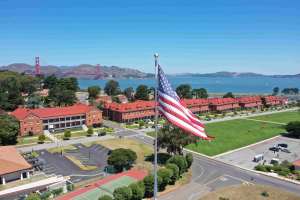Presidio's Newest Trail Links Mountain Lake and Baker Beach

Presidio of San Francisco (June 3, 2011) — Presidio bird watchers have long flocked to the sandy dunes behind the former Public Health Services Hospital (now the Presidio Landmark). Today their path is made easier by the Presidio’s newest trail–a segment of the Mountain Lake Trail that allows visitors to experience the restored dunes.
The new trail wraps itself around the northern edge of the Public Health Service District for a quarter mile, from Battery Caulfield Road, east to the Park/Anza trail. The Mountain Lake Trail will eventually provide a major east-west corridor linking the Broadway Gate with Baker Beach.
“This was always an important birding spot,” says Amy Deck, project manager for trails for the Presidio Trust. “Park users had cut a social trail along the southern edge of the dunes – so there was always a desire to have a trail here.”
“The trail has a remote, rustic feel” Deck continues. “But it is also a central part of our trail network, creating a direct link between the Mountain Lake area and Baker Beach. Especially now with the Public Health district welcoming a new community, it will be a good connection for the residents.”
A central feature of the new trail is the “Marine Cemetery Vista” which overlooks a former merchant marine cemetery, honoring the seamen from around the world who died at the hospital that was once the focal point of the district. Between 1881 and 1912, several hundred sailors from 30 states and 43 countries were buried there. Later this summer, a memorial stone plaque will be installed at the vista in tribute to these merchant mariners.
The cemetery, which dates back more than 130 years, is now covered with sand dunes, which are dotted with thousands of freshly planted native dune grasses and plants, including the endangered San Francisco Lessingia, which is found in only two spots in the world (a small patch of San Bruno Mountain is the other). All told, hundreds of Presidio Park Stewards and other volunteers planted more than 16,000 plants over three-and-a-half acres, part of the Trust’s efforts to restore endangered habitat along the length of the new trail.
In keeping with the Trust’s goals of increasing accessibility throughout the Presidio’s trail network, the western portion of the trail, from the vista to Battery Caulfield Road, is accessible to people with disabilities.
To the east of the vista, the Presidio’s newest boardwalk winds its way behind the restored Wyman Avenue homes. The redwood boardwalk is the park’s third (the Lobos Creek Valley Trail and a small section of Lovers Lane are the other two). It was built to allow for the natural movement of the dunes. A small section of the boardwalk was elevated and laid across concrete piers to minimize the impact on a giant Monterey Cypress tree adjacent to the trail.
Presidio trails and overlooks are being transformed through the Trails Forever initiative, a partnership between the Golden Gate National Parks Conservancy, National Park Service, and Presidio Trust. Improvements to the Mountain Lake Trail were made possible by a lead gift and challenge grant from the Evelyn and Walter Haas, Jr. Fund and the many donors who contributed matching funds for the revitalization of the Presidio’s trails, bikeways, and overlooks. In total, twelve major trail corridors will be upgraded as part of a comprehensive trail improvement program. Projects include pedestrian and bike paths as well as scenic overlooks, which highlight some of the park’s iconic vistas. Once complete, the trail network will provide a variety of opportunities to explore the park — from rugged hiking trails to in-road bike lanes — providing a welcoming experience for visitors of all abilities and interests.
The Presidio Trust was established by the United States Congress in 1996 to administer the Presidio of San Francisco, an urban national park site located at the base of the Golden Gate Bridge. The areas overseen by the Trust include expansive open space and spectacular views, a 300-acre historic forest, and rare and endangered plants and wildlife. The park is home to 13 distinctive plant communities featuring 280 native plant species, 16 of which are rare or endangered. Thousands of hours of volunteer work have restored many acres of natural resource habitat. The Presidio Native Plant Nursery grows 60,000 plants each year to make this restoration possible. Twenty-first-century “green” practices are employed in all building and landscape rehabilitation efforts.